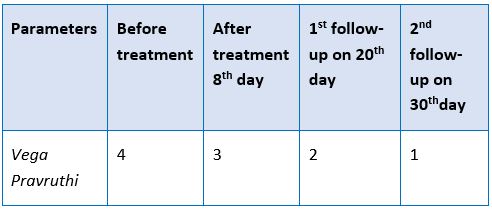Role of Marma therapy and Vidangadi Avapidana Nasya in the management of Ardhavabhedaka [Migraine] - A Single Case Study
DOI:
https://doi.org/10.21760/jaims.9.7.49Keywords:
Ardhavabhedaka, Shalakya Tantra, Marma Therapy, Nasya Karma, Ayurveda Management of MigraineAbstract
Modern technology and equipment have allowed man and science to reach new heights in the realm of medicine. Despite its Vedic essence, Ayurveda continues to be widely practiced and serves humanity with its own set of principles and philosophy. The Shalakya Tantra primarily addresses ailments that arise above the clavicle and their treatment. Ardhavabhedaka, or Migraine, is a prevalent Shirogata Vyadhi influenced by diverse factors such as lifestyle modifications, psychological stress, and various sources of Shirogata disturbances. In Ayurveda, Ardhavabhedaka is understood as a Vataja or Vata-Kaphaja impacting all facets of Shirogata physiology. The symptoms of Ardhavabhedaka include Ardha Murdha Vedana, Pakshath Dashahath Pravruthi, Bhrama, Bheda Todavath Vedana, Chardi. Traditional Ayurvedic treatments address these symptoms through localized and systemic approaches. This study aims to assess the effectiveness of Marma therapy and Nasya Karma in alleviating symptoms and improving clinical parameters associated with Ardhavabhedaka. The findings offer promising insights into potentially cost-effective alternatives for managing Ardhavabhedaka, providing relief to individuals burdened by the perpetual dependence on palliative measures.
Downloads
References
https://ichd-3.org/1-migraine/
https://www.ncbi.nlm.nih.gov/pmc/articles/PMC4510104/
Sunil Kumar Joshi. Marma Science and Principles of Marma Therapy, New Delhi, Vani Publications, 2019 page- 33
Sunil Kumar Joshi. Marma Science and Principles of Marma Therapy, New Delhi, Vani Publications, 2019 page- 9
Sunil Kumar Joshi, Marma chikitsa vigyan, DK traders’ publication Delhi, 2nd edition 2012,chepter 4,page no-166.















